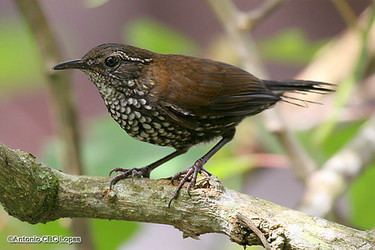Ovenbirds or furnariids are a large family of small suboscine passerine birds found in Mexico, and Central and South America. They form the family Furnariidae. The ovenbird (Seiurus aurocapilla), which breeds in North America, is not a furnariid – rather it is a distantly related bird of the wood warbler family, Parulidae.
The ovenbirds are a diverse group of insectivores which get their name from the elaborate, vaguely "oven-like" clay nests built by the horneros, although most other ovenbirds build stick nests or nest in tunnels or clefts in rock. The Spanish word for "oven" (horno) gives the horneros their name. Furnariid nests are always constructed with a cover, and up to six pale blue, greenish or white eggs are laid. The eggs hatch after 15 to 22 days, and the young fledge after a further 13 to 20 days.
They are small to medium-sized birds, ranging from 9 to 35 cm in length. While individual species often are habitat specialists, species of this family can be found in virtually any Neotropical habitat, ranging from city parks inhabited by rufous horneros, to tropical Amazonian lowlands by many species of foliage-gleaners, to temperate barren Andean highlands inhabited by several species of miners. Two species, the seaside and the surf cinclodes, are associated with rocky coasts.
Recently, the woodcreepers (formerly Dendrocolaptidae) were merged into this family, following analysis of mtDNA cytochrome b and several nDNA sequences. While confirming the overall phylogenetic pattern, other scientists instead opted for maintaining the woodcreepers as a separate family, while splitting the ovenbirds (as traditionally defined) into two families, Furnariidae and Scleruridae.
The systematics of the Dendrocolaptinae were reviewed by Raikow (1994) based on morphology and by Irestedt et al. (2004) based on analysis of nuclear and mitochondrial DNA. Using the latter approach, the suspected major lineages of the Furnariinae (foliage-gleaners, spinetails, and true ovenbirds) were confirmed, but some new lineages were discovered and the relationships of several genera had to be revised.
The taxonomic arrangement presented below is based on recent studies of ovenbird relationships. However, because ovenbirds and woodcreepers are treated here as a single family some taxonomic ranks were modified.
Subfamily: Sclerurinae – miners and leaftossers
Genus Geositta – miners (11 species)Genus Sclerurus – leaftossers (5 species)Subfamily: Dendrocolaptinae – woodcreepers For a complete listing of species, see the subfamily article.
Tribe: Sittasomini – "intermediate" woodcreepers Genus Dendrocincla – woodcreepers (6 species)Genus Deconychura – long-tailed woodcreeperGenus Sittasomus – olivaceous woodcreeperGenus Certhiasomus – spot-throated woodcreeper (recently described for Deconychura stictolaema)Tribe: Dendrocolaptini – "strong-billed" woodcreepers Genus Glyphorynchus – wedge-billed woodcreeperGenus Nasica – long-billed woodcreeperGenus Dendrexetastes – cinnamon-throated woodcreeperGenus Dendrocolaptes – woodcreepers (5 species)Genus Hylexetastes – woodcreepers (2–4 species)Genus Xiphocolaptes – woodcreepers (4 species)Genus Dendroplex – straight-billed woodcreepers (2 species, formerly in Xiphorhynchus)Genus Xiphorhynchus – woodcreepers (some 15 species, possibly polyphyletic)Genus Lepidocolaptes – narrow-billed woodcreepers (7 species)Genus Drymornis – scimitar-billed woodcreeperGenus Drymotoxeres – greater scythebillGenus Campylorhamphus – scythebills (4 species)Subfamily: Furnariinae – Neotropical ovenbirds and allies
Genus: Xenops – xenops (3 species)Genus Berlepschia – point-tailed palmcreeperTribe PygarrhichiniGenus Pygarrhichas – white-throated treerunnerGenus Microxenops – rufous-tailed xenopsGenus Ochetorhynchus – earthcreepers (2 species formerly included in Upucerthia)Tribe Furnariini – horneros and alliesGenus Pseudocolaptes – tuftedcheeks (2 species)Genus Premnornis – rusty-winged barbtailGenus Tarphonomus – (new genus for 2 species formerly included in Upucerthia)Genus Geocerthia – striated earthcreeper (recently described for U. serrrana)Genus Upucerthia – earthcreepers (5 species)Genus Cinclodes – cinclodes (some 12 species)Genus Furnarius – horneros (6 species)Genus Lochmias – sharp-tailed streamcreeperGenus Phleocryptes – wren-like rushbirdGenus Limnornis – curve-billed reedhaunterTribe Philydorini – foliage-gleaners and alliesGenus Megaxenops – great xenopsGenus Anabazenops – foliage-gleaners (2 species)Genus Ancistrops – chestnut-winged hookbillGenus Cichlocolaptes – (2 species)Genus Heliobletus – sharp-billed treehunterGenus Philydor – foliage-gleaners (7 species)Genus Anabacerthia – foliage-gleaners (5 species)Genus Syndactyla – foliage-gleaners (8 species)Genus Clibanornis – (5 species)Genus Thripadectes – treehunters (7 species)Genus Automolus – foliage-gleaners (8–9 species)Tribe Synallaxini – spinetails and alliesGenus Margarornis – treerunners (4 species)Genus Premnoplex – typical barbtails (2 species)Genus Aphrastura – rayaditos (2 species)Genus Leptasthenura – tit-spinetails (10 species)Genus Pseudoseisura – cacholotes (4 species)Genus Spartonoica – bay-capped wren-spinetailGenus Sylviorthorhynchus – Des Murs's wiretailGenus Asthenes – canasteros (27 species)Genus Pseudasthenes – "false canasteros" (4 species, recently described)Genus Certhiaxis – spinetails (2 species)Genus Schoeniophylax – chotoy spinetailGenus Synallaxis – spinetails (some 30–35 species)Genus Poecilurus (3 species, usually included in Synallaxis)Genus Hellmayrea – white-browed spinetailGenus Cranioleuca – typical spinetails (c.20 species)Genus Limnoctites – straight-billed reedhaunter (sometimes included in Limnornis, but closer to, and possibly better merged with Cranioleuca)Genus Roraimia – Roraiman barbtail (formerly in the "Margarornis group")Genus Thripophaga – softtails (4 species)Genus Phacellodomus – thornbirds (9 species)Genus Anumbius – firewood-gathererGenus Coryphistera – lark-like brushrunnerGenus Siptornis – spectacled prickletailGenus Metopothrix – orange-fronted plushcrownGenus Xenerpestes – graytails (2 species)Genus Acrobatornis – pink-legged graveteiro
